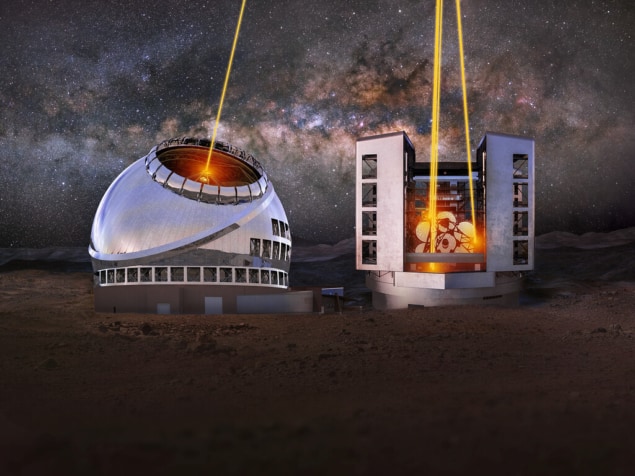
The US National Science Foundation (NSF) has announced it will only support the construction of the Giant Magellan Telescope (GMT) or the Thirty Meter Telescope (TMT) – but not both facilities. The decision to pick just one next-generation, ground-based instrument came as the National Science Board (NSB), which oversees the NSF, set a limit of $1.6bn for its Extremely Large Telescope programme (US-ELTP). The board says it will discuss the NSF’s “plan to select which of its two candidate telescopes to continue to support” at its meeting in May.
Both the GMT and the TMT are seen as the future of US ground-based astronomy and stem from advances in mirror technology. The GMT will rely on seven primary and seven secondary mirrors to give it an optical surface of 24.5 m. Building is already under way at Chile’s Las Campanas peak.
The TMT, meanwhile, will use a segmented primary mirror consisting of 492 elements of zero-expansion glass for a 30 m-diameter primary mirror. The team has chosen Hawaii’s Mauna Kea peak as its location.
However, protests by indigenous Hawaiians, who regard the site as sacred, have delayed the start of construction. The issue might even force a change of the TMT’s location with officials identifying the island of La Palma, belonging to Spain’s Canary Islands, as an alternative site in 2019.
Going it alone
In 2018 the two telescope teams joined forces to create US-ELTP to give US researchers access to giant telescopes in both the Northern and Southern hemispheres. A further boost came in 2020 when the two telescopes emerged from Astro2020, the most recent decadal survey of U.S. astronomy and astrophysics, as a main priority for the community.
The decision for the NSF to now only focus on one design comes after a reduction in funds for science-based government agencies in the current financial year, which began on 1 October 2023. Contentious negotiations among the Republican-majority House of Representatives, the Democratic-majority Senate, and Democratic US President Joe Biden have resulted in a cut of 8.3% in the NSF’s proposed budget. At $9.06bn, it falls about $820m short of the financial year 2023 amount.
At a meeting in late February, the NSB pointed out that any figure greater than $1.6bn for US-ELTP would impoverish other major projects supported by NSF. Yet the decision has not surprised insiders. Michael Turner, a cosmologist from the University of Chicago, wrote in Science last November that it was “simply not possible for NSF to join both projects at the level needed to make each successful”.

Giant Magellan Telescope receives cash injection from the National Science Foundation
The GMT and TMT, both of which have support from various US universities, are not, however, entirely American projects. The GMT works with institutions in Asia, Australia and South America, while TMT’s partners include research organizations in Canada, India and Japan.
Indeed, in a letter published in Science on 16 February days before the NSB’s decision, the executive director of the TMT and president of GMT – along with the director of the NOIRLab, the US national center for ground-based observatories – wrote that overseas and US partners “are on a path to contribute a substantial portion of the $3bn required for each of our telescopes” adding that they “advocate US government funding for both telescopes”.
Any further delays to the US programme, however, would give Europe the edge when it comes to making discoveries with a next-generation ground-based telescope. The European Southern Observatory’s Extremely Large Telescope is already under construction in Chile’s Cerro Amazones region. With a primary mirror of 39 m, first light is planned for 2028.
- SEO Powered Content & PR Distribution. Get Amplified Today.
- PlatoData.Network Vertical Generative Ai. Empower Yourself. Access Here.
- PlatoAiStream. Web3 Intelligence. Knowledge Amplified. Access Here.
- PlatoESG. Carbon, CleanTech, Energy, Environment, Solar, Waste Management. Access Here.
- PlatoHealth. Biotech and Clinical Trials Intelligence. Access Here.
- Source: https://physicsworld.com/a/battle-for-the-skies-us-insists-gmt-and-tmt-telescopes-must-vie-for-funding/



